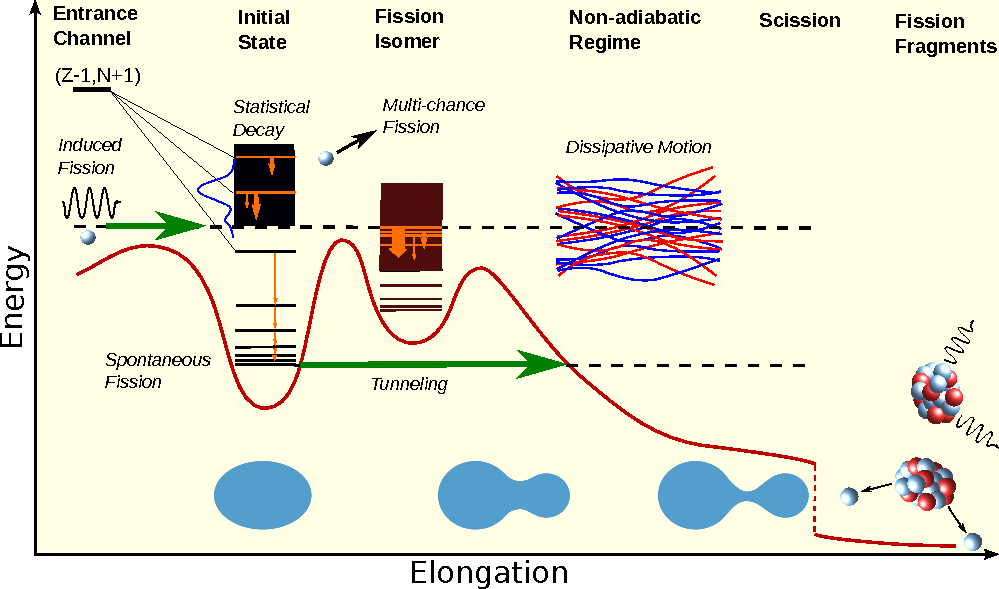1 Introduction
The theory of nuclear fission has a long history, driven for many years by technological applications and heavy element studies. Today the needs are even broader with the recognition of new connections to other disciplines such as astrophysics and fundamental science.
In the past, fission theory was largely phenomenological. Recent significant advances in microscopic modeling, which can be tested thanks to the rapid growth in computational capabilities including leadership-class computers, provide opportunities for developing fission theory to a new level of refinement. In addition, experimental fission data of unprecedented detail and quality are now being acquired and can be used to validate models more thoroughly.
A disclaimer is in order, because we used the word “microscopic” in the previous paragraph. In the context of fission theory and indeed all theory that is applied to large nuclei, “microscopic” should not be construed as an ab initio many-body theory with all Hamiltonian input taken from the outside. In our field, theory is useful at a quantitative level only if the parameters, or coupling constants, of models are optimised to experiment. For that reason, all quantitative nuclear models are phenomenological at some level. Superlatives such as ‘fully microscopic’ or ‘from first principles’, sometimes used to characterise particular approaches, may be viewed more as wishful thinking than the present reality. However, it is useful to distinguish the degrees of phenomenology in different theoretical approaches. In this document we will use the term “microscopic theory” for theoretical approaches in which nucleonic degrees of freedom are explicitly present together with inter-nucleon forces. The most prominent example is nuclear density functional theory which is based on effective nucleon-nucleon interactions that generate mean fields and the associated single-particle orbitals. In this document we assess the future promise of a number of extensions of density functional theory. Some of them remain microscopic, but others are best characterised as phenomenological.
This document was initiated at the Workshop on Future of Theory in Fission held in York in October 2019 (https://www.york.ac.uk/physics/news/events/groups/nuclear-physics/2019/future-of-theory-in-fission-workshop/). The premise of the meeting was that fission theory is ripe for rapid progress. Consequently, the focus was on future developments, perspectives, and challenges. The questions motivating the workshop were:
-
•
Considering the broad range of observables, what are the physics objectives that fission theory needs to address?
-
•
What are realistic goals that can be achieved with advanced microscopic frameworks and modern computational tools?
-
•
Can microscopic theory provide justification for successful phenomenological assumptions and models?
-
•
Which current approximations routinely made in fission studies are justified or not, or unavoidable or not, in view of the present-day computational capabilities? What are the robust approximations that can be employed to simplify the treatment and/or reduce the computational effort?
-
•
Is it realistic to envision a unified microscopic theory of fission that would cover the entire energy range from spontaneous fission to fission well above the barrier?
-
•
What are the best strategies for the community to optimise fission theory research?
As seen from the table of contents, this document summarises the broad range of topics covered in the York Workshop. Our unifying theme is the pathway towards solving the fission problem via modern many-body frameworks by taking advantage of the latest computational methodologies. In this context, the main purpose of this document is to outline challenges and point to possible solutions rather than to provide a detailed review of nuclear fission theory. The interested reader is encouraged to consult recent reviews of various aspects of fission theory, e.g., Schunck and Robledo (2016) (overview of microscopic models) and Andreyev et al. (2017); Talou et al. (2018); Schmidt and Jurado (2018) (description of state-of-the-art fission phenomenology), which contain extensive lists of references.

Of the various shape regions depicted in figure 1, we shall cover microscopic dynamics in the domains around the initial state and the barriers as well as the highly deformed region beyond. But we are leaving out the important challenge of describing how the system propagates from one region to another because there has been virtually no coherent microscopic theory addressing this question up to now. This underscores the fact that there will still be much future work to do in nuclear fission theory.